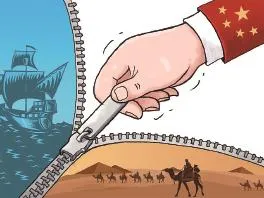“一带一路”何以应者云集?
“一带一路”何以应者云集?

The Belt and Road Forum for International Cooperation will be held in Beijing from May 14th to 15th. At present, many high-ranking officials have confirmed to attend the meeting, including more than 20 foreign leaders, presidents of more than 50 international organisations, more than 100 ministerial officials and a total of more than 1,200 representatives from all over the world. This not only reflects the support and expectation from the international community, but also reflects that this initiative has risen from a Chinese proposal to an international consensus.
People ask, why did this initiative receive such a warm welcome? And why has the forum attracted such attention in the international community?
The fundamental reason is that with uncertainties of international relations and weak growth of the world economy, China has provided public goods that could make global development more inclusive and inter-connected.
In general, the meaning of public goods is threefold: material public goods, conceptual public goods and institutional public goods. To help other countries with the construction of their roads, bridges, power supplies, etc., is supplying the levels of human, finance, products and other material supplies, so it belongs to material public goods. Conceptual public goods refers to the provision of wisdom and programs to address and solve global problems. The institutional public goods represented by the "Belt and Road" initiative is the transcendence of the traditional concept,

which represents the trend of bringing “the marginal” back into the international community and helping them develop. It also indicates that the focus of international cooperation has shifted from being function-oriented to human-centered.
With the construction of the “Belt and Road”, Chinese policy expressions such as “road”, “belt”,“corridor”, “bridge” and others have been attracting more and more attention. "Connectivity" started to become a popular banner. Chinese culture and Chinese philosophical thinking, such as "Pain is caused by blockage, if it is no longer blocked, then you won't feel pain ", gained more and more respect. Whether the initiative will succeed depends on the full implementation of international consensus. And the BRF will be held for this significant purpose. The Belt and Road is not only a Route, but the Tao (Way) of co-development. We have every reason to believe, representatives will use profound intellectual analysis and fresh cases to show both the tactics and Tao/rationale of this initiative in the forum.

Zhao Lei
professor at the Institu te for International Stra tegic Studies of the Pa rty School of the Centr al Committee of the CP C, a director of the Res earch Office for Interna tional Relations and Na tional Unity. Mr. Zhao heads a key research project on the Belt and Road Initiative at CPS, and is the founder of th e forum “The Belt and R oad 100”.
赵磊
中共中央党校国际战略研究院教授、国际关系与国家统一研究室主任、中央党校“一带一路”重点研究课题主持人,“一带一路百人论坛”发起人。
“一带一路”国际合作高峰论坛将于5月14日至15日在北京举行。目前已有20多位外国领导人、50多位国际组织负责人、100多位部长级官员以及总共1200多名来自世界各国、各地区的代表确认与会。这体现了国际社会对“一带一路”建设和高峰论坛的支持和期待, 也折射出“一带一路”已从中国倡议上升为国际共识。
人们不禁要问,“一带一路”何以应者云集?高峰论坛何以备受瞩目?
其根本原因正在于,在当前国际形势面临诸多不确定性、世界经济增长乏力的情况下,中国为全球治理提供了实现包容和联动发展的公共产品。
笼统而言,公共产品包含三个层次:物质性公共产品、理念性公共产品和制度性公共产品。帮助其他国家修路、造桥、供电等,是在人、财、物等物质性需求层面的供给,属于物质性公共产品。理念性公共产品,是指为应对和解决全球性难题提供智慧和方案。而“一带一路”所代表的制度性公共产品,是对传统理念的超越,代表着国际社会“消除边缘”的发展潮流,也预示着国际合作的焦点从功能定位走向人文定位。
随着“一带一路”建设迅速推进,路、带、廊、桥等中国式话语广受关注,“互联互通”开始成为一种时尚,“痛则不通、通则不痛”的中国式文化与哲学思想开始备受瞩目。“一带一路”既是中国倡议,又是国际共识,其成功需要充分凝聚国际智慧,这也正是此次高峰论坛举行的意义所在。“一带一路”,不仅是“路”,更是“道”。我们有理由期待,在高峰论坛上,各方代表将用深刻的学理剖析与鲜活的具体案例,既把“一带一路”的术讲好,更把其蕴含的势和道讲得入耳入心。
Why Did the “Belt and Road” Initiative Receive Such A Warm Welcome?
Text by Zhao Lei Translation by Tao Wenjia Photos by CFP

